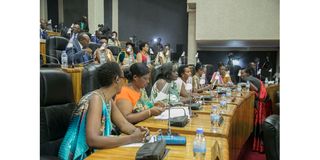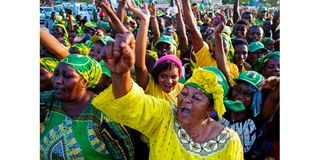How countries that pioneered electoral gender quota are fairing

Rwanda's women legislators in parliament. The country has the highest ranking for female representation across the world.
What you need to know:
- In the 1990s and early 2000s, governments or political parties introduced electoral gender quotas which increased women’s representation in Parliament and local councils.
- In 1994, South Africa's ANC adopted a voluntary party quota of 30 per cent representation of women in politics and decision-making.
- Tanzania’s 1977 Constitution opened the door for women to get into political leadership.
Due to the slow speed by which the number of women in politics was growing in Africa, governments and political parties introduced electoral gender quotas in the 1990s and early 2000s. This increased women’s representation in Parliament and local councils.
We look at the progress made this far in these countries that include Tanzania, Namibia, Mozambique, Uganda and South Africa. Others are Eritrea, Rwanda, Burundi, and Angola.
Tanzania
Tanzania’s 1977 Constitution opened the door for women to get into political leadership. According to Article 66 (1b), National Assembly should be constituted of not less than 30 per cent of women.

Women cheer during a ruling Chama Cha Mapinduzi (CCM) rally in Dar es Salaam, Tanzania, in 2015. Regionally, Tanzania ranks eighth in the women’s political inclusion in Parliament.
International Institute for Democracy and Electoral Assistance, further indicates that Chama Cha Mapinduzi, Civic United Front, National Convention for Construction and Reform, and Chama cha Demokrasia na Maendeleo, adopted voluntary quotas, including at least one woman candidate to stand for election in each constituency. Regionally, Tanzania ranks eighth (37 per cent) in the women’s political inclusion in Parliament.
Namibia
The Local Authorities Act, 1992, provided inclusion of at least two women in the party lists for the elections of local authority councils with ten or fewer members. In case the council members were 11 or more, women were allocated at least three slots. These numbers of women were later in 1997, increased to three and five, respectively.
Thereafter in 2013, ruling party in the National Assembly, South West African People's Organisation (Swapo), adopted a 50 per cent gender quota applicable in all its national and regional structures of the party.
Today, Namibia ranks third among African countries with highest representation of women in Parliament - with a 44 per cent proportion.
Mozambique
In 1994, the dominant political party, Mozambique Liberation Front, adopted a policy on 30 per cent women representation in the National Assembly and local government. This move by the ruling party is what the Electoral Institute for Sustainable Democracy in Africa attributes to increased representation of women in public life. However, data from Gender Links shows representation dropped to 37.6 per cent in 2019, from 39.6 per cent in 2014.
Uganda
Article 78 (1) of the 1995 Uganda Constitution provided for election of one woman representative for every district. There are 112 districts in the country.
Parliamentary Elections Act (2005) also required that of the 10 representatives of the Uganda People’s Defence Forces, two must be women. And out of five youth representatives, one must be a woman.
Additionally, among the five people selected to represent each of the groups of persons with disabilities and workers, one must be a woman. At the moment, 35 per cent of Uganda’s legislators are women, making it the ninth country with highest representation in Africa.
South Africa
In 1994, Africa National Congress (ANC) adopted a voluntary party quota of 30 per cent representation of women in politics and decision-making. The party incorporated the quota provision in its guidelines for nominations of public representatives.
Then in 1998, Local Government: Municipal Structures Act was enacted, providing a pathway for political parties to ensure 50 per cent of the candidates included in the party list are women.

Members of South Africa's African National Congress (ANC) Women's League. In 1994, ANC adopted a voluntary party quota of 30 per cent representation of women in politics and decision-making.
In 2006, ANC enhanced its quota system to 50 per cent for local elections. Then in 2009, it extended the 50 per cent to the national elections.
Presently, South Africa is behind Rwanda at 46 per cent in representation of women in Parliament
Eritrea
Proclamation No.86/1996 on the establishment of Local Government reserved 30 per cent of the seats for women in the Regional Assemblies. The Eritrean government’s report on Implementation of the Beijing Platform for Action, indicates that women currently make up 22 per cent of the National Assembly members. While in the six regional assemblies, their representation ranges between 27 per cent and 37 per cent.
Rwanda
Article 9 (4) of Rwanda’s 2003 Constitution indicates that “building a State governed by the rule of law, a pluralistic democratic Government, equality of all Rwandans and between men and women which is affirmed by women occupying at least 30 per cent of positions in decision-making organs."
Further Article 82 on composition of the Senate requires that of the 26 senators elected or appointed, at least 30 per cent of them must be women. Currently, the country ranks the highest in Africa with a 61 per cent representation of women in Parliament.
In the 2009 report on Sustaining Women’s Gains in Rwanda: The Influence of Indigenous Culture and Post-Genocide Politics, the then Member of Parliament Athanasie Gahondogo, is quoted to have said: “It is now becoming more of a surprise to find no women in any committee than to find many women, and both men and women will point out any discrepancy when it exists.”
Burundi
Georgetown Institute for Women, Peace and Security indicates that after the 2005 Constitution, which introduced a 30 per cent hold for women in Parliament, there were historic wins in the 2005 elections. In the National Assembly, women representation rose to 36.8 per cent from 12 per cent. So did in Senate from 19 per cent to 31 per cent. Now, at 38 per cent, Burundi ranks eighth in the 10 African countries with highest women representation.
Angola
Article 20 (2m) of 2005 Law 2/05 on Political Parties established a Charter obligating political parties to have rules promoting equal opportunities and equity between men and women, as well as a gender representation of not less than 30 per cent in the elective or appointive bodies.
Women’s participation in public life has, however, been rising and falling since 2008 (37 per cent). It rose to 39 per cent in 2009, then dropped to 34 per cent in 2013. It then jumped to 36 per cent in 2017 and fell to the current 30 per cent.
Local leaders have been urging parties to boost women’s representation in political leadership. In 2012, for instance, Agência Angola Press reported the then Member of Parliament Emilia Carlota Dias, urging political parties to have more women in the party lists.





